Intersection Between Love And Power
[Below is an edited transcript of the informal talk I shared at the ServiceSpace retreat in 2016. Gratitude to Anuj for the back-end work that led to a transcript.]
I'm going to take a little bit of a systems or telescopic lens in talking about inner transformation. In this ecosystem, we focus so much on leading with inner transformation and the ripples that follow from small acts, and so I want to explore that “ripples-based” Gandhian model of change in the context of our broader systems operating socially, and the relationship between systems and inner transformation. Again [to use our language from yesterday], what is the relationship between the circle and the square? Should we keep focusing on the circles and ever-widening ripples, or do we at some point also have to worry about the design of the square [hierarchical systems and institutions] which may constrain and hold in those ripples?
One of the themes that I have been exploring in my own work throughout my life is the role of external systems/coercion in supporting or constraining the conditions and freedom for inner work. Coercion meaning the systems we set up, the rules we set up, and the structures we set up. There's a tension in some ways, or a continuum between the focus on small acts, which is what the ServiceSpace model is, and the overarching matrix of external constraints that we operate in. Moving the ripples can start to affect the systems around us, but these broader overarching systems act upon and constrain the ripples and movement from within.
So, for example, we may think we have consciousness and choice about the food we eat, but we are tied to certain food, agricultural and soil systems that significantly constrain what we are presented with in making our choices. We may think we have consciousness about the health care decisions we make, but we operate within certain health systems that present those choices to us and in some cases channel or constrain us dramatically. The idea of 'voluntary action building up the voluntary sector' is a powerful one. But we also must understand the continuum between voluntary action and the role of systemic forces that constrain us and limit the scope of voluntary action.
To give you a sense of where I’m coming from: I'm a constitutional lawyer. In most societies, law is a form of legitimized restraint. The legitimacy is based on the societal acceptance that laws are the "wise restraints that make men free". We can also have unwise restraints that bind and constrain us – or that constrain us unequally (more on that later). But the idea of law is that without these rules or restraints there would be violence and potential anarchy, which would make the work of inner transformation – or just about any individual work – significantly more difficult. Just like a traffic light restrains people’s journeys but ultimately enables many to pursue different directions without running into one another, laws set certain baseline social, external conditions and so enable people to pursue their own individual interests.
We’ve marveled this week about the brilliant manner in which ServiceSpace can hold a circle, which is a social space or group/collective space for inner transformation. The circle is clearly a design principle that brings a lot of us together in this community. As practiced within this ecosystem, the circle process is a brilliant design. We've talked a lot about the unbelievably gifted design sensibilities behind ServiceSpace, and the tremendous forethought and effort that is made to make everything – the spaces that hold us – feel effortless; the work that goes behind the design of the space that allows each of us to do the inner work.
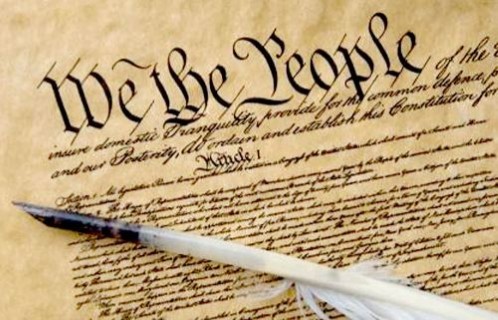
In many ways a lot of similar effort goes into the design of our broader laws and social systems to allow individual work to occur and to feel effortless as well. The American Constitution, which is the longest lasting written constitution in the history of the world, in many ways sets forth a really brilliant design. There are historical shortcomings, obviously, and it's continued to evolve as we have brought more people into its coverage and formed a “more perfect union,” but I want to just talk about it for a second, because I think it sets the stage for this discussion of the design of social systems for inner transformation.
The creators of the Constitution were very much rooted in the life of the spirit. They studied metaphysics. They studied various religious and philosophical traditions. They came upon a system where they aimed to create a safe space for individual flourishing. They were masters of understanding how to come to communal understanding – through individuals listening to another – and of the relationship with the individual with the group. The constitution is all about creating a space by which people relate to one another, and how the individual spirit emerges from, and through interactions among, the group. The founders wanted to create a space for conscience and freedom of thought that could emerge amid social activity. They were very influenced by Quakerism. They were influenced by the mystics. I won't go into a lot of the detail about this [their background understandings], but they were masters of understanding the life of the mind and how it relates to the life of the spirit and how it relates to the life of the community.
Ultimately, much of their thinking about creating safe communal spaces for individual flourishing found expression in the first amendment, which was the first freedom: Freedom of thought, freedom of assembly, the freedom of religion, the freedom of conscience. That carried over into the international sphere with the Universal Declaration of Human Rights, which was adopted by most countries after WWII – across cultural and religious divides.
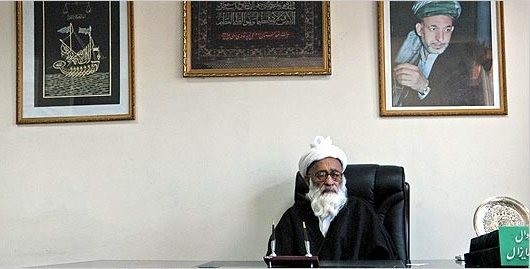
About 15 years ago – or rather in 2003, right after the invasion of Afghanistan by the US, I was involved in the US’s efforts help the Afghans set up a new government and draft a new constitution. This experience really hit home the importance of the role of freedom of conscience. The chief justice of the Afghan supreme court was the head of the Constitutional Drafting Committee in Afghanistan. We met with him, and were talking to him about the Universal Declaration of Human Rights, to which Afghanistan was a signatory and committed to upholding, trying to encourage them to incorporate its basic human freedoms into the constitution. At one point – and it was just me and a Jewish woman, representing the US, who were speaking to him – he kind of looked at us -- very nice, smiling, and somewhat amused at having this meeting with us. At the end, he's like, "I agree with everything you have to say. I agree with all 30 articles of the Universal Declaration of Human Rights except for 3." We asked, "Which 3?" He said, "Freedom of speech, freedom of religion/conscience, and the rights of women." The three he hit upon are central freedoms which in many ways become the underpinning of many other freedoms – and his singling them out underscored that. Then he started thumping on the Quran. He said, "We don't need a constitution. This is our constitution."
It was an extraordinary experience working with a range of Afghans – from their interim leaders to civil society groups to individual dissenters – at a founding moment and working with them to understand how to create or encourage the creation of a broader social space where there's the right of dissent, or how individuals feel free to dissent from state-imposed orthodoxy. How does the broader societal structure or circle – representing the sphere of social or communal space – not become about keeping people out, and instead, become a space for individual spirits to flourish and thrive – for inner as well as outer transformation, in other words?
This to me is a key issue – and that is that the designs of our social systems matter, because the social structures and external spaces we inhabit can either allow for or encourage inner transformation, or stifle it. All of the systems that we live in, the social system, the digital spaces we occupy (that ServiceSpace is so involved in creating), or the Wednesday Awakin circles, these are all spaces where the design principles behind them very much affect our experiences and choices – and therefore we should seek to affect them in a way that allows us to bring forth our true inner worlds. The spheres are part of our societal matrix that affect our inner development, and there's a dance between the inner and the outer.
Rather than framing these social spaces as a circle, which can be double-edged because in some societies a circle excludes as much as it includes, I like the concept of the Mobius strip, which is really Parker Palmer’s concept.

A Mobius strip is a circle or a band where, before the two ends have joined, one has been twisted around, and so they are joined with one end inside-out. And so what happens is that as you trace your hand along what seems to be the inside of the strip, it slowly becomes the outside of the strip. The idea is that the inside spaces and the outside spaces keep flowing into one another and co-creating each other – the strip has a finite area but infinite perimeter, suggesting that in the constant exchange between the inner and the outer, we and the world are constantly re-made. We have true integration between our inner work and our outer work. As we change, we change our world, yes, but also – as our outer world changes, it changes the space of our inner work. And so I believe we need to understand – and affect – the ways in which the designs of our social spaces affect (support or inhibit) our processes of inner transformation, just as we focus on inner transformation as a way of shifting the world.
There's the dance between the inner and the outer, and focusing sometimes only on the inner ignores the role of the outer in how it shapes the inner. Systems matter. Talking about inner transformation is, I would say, a critical part ... but it is, in my view, half of the picture of the dance. We are able to assemble peaceably and join Wednesday circles only because of a certain social system that supports and allows private assembly and allows us these safe spaces to do our inner work without fear of violence.
Going back to the notion that we started with, which is coercive power verses love, role of systems versus the role of inner transformation. This is a quote I've kind of paraphrased. It's not exact, but from Reinhold Neibuhr, where he said, "Power without love is brutality, but love without consideration of power is sentimentality. How to make power express love, and love humanize power, is the distinctive task for the next hundred years." He wrote this back in the 1920s. Again, we can lead from the inside out, but I would suggest that we need also to think about the outside and how it impacts the realm of love.
This was just another version of that quote, which I thought expressed it very well. This is Martin Luther King Jr paraphrasing Gandhi: "Power without love is reckless and abusive, and love without power is sentimental and anemic. Power at its best is love implementing the demands of justice, and justice at its best is power, correcting everything that stands against love."
I want to explore the intersection between love and power in the context of three short little case studies.
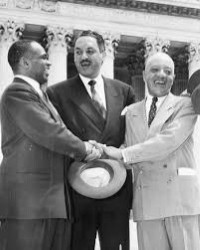 One is the desegregation of schools and public accommodations in America. There's among lawyers, amongst public policy theorists, a fundamental divide about what really led to the desegregation of our society. Was it changes in law, top-down from Supreme Court or was it the bottom up love? Was it Thurgood Marshall, the lawyer who argued Brown vs Board of Education that led to the desegregation of American schools via a unanimous Supreme Court decision that mandated change at the local level from "on high", or was it Martin Luther King's deep heart-based work and community organizing -- that culminated in legislative changes via the political process, namely the Civil Rights Act and Voting Rights Act?
One is the desegregation of schools and public accommodations in America. There's among lawyers, amongst public policy theorists, a fundamental divide about what really led to the desegregation of our society. Was it changes in law, top-down from Supreme Court or was it the bottom up love? Was it Thurgood Marshall, the lawyer who argued Brown vs Board of Education that led to the desegregation of American schools via a unanimous Supreme Court decision that mandated change at the local level from "on high", or was it Martin Luther King's deep heart-based work and community organizing -- that culminated in legislative changes via the political process, namely the Civil Rights Act and Voting Rights Act?
It was important that the Supreme Court decision that resulted from Thurgood Marshall’s advocacy was unanimous, because it didn't legitimize any social dissent. I've always felt and I think a lot of lawyers always feel that law has an incredible power in that it sets forth aspirational norms. I mean -- it wasn't when the Supreme Court said all schools had to be desegregated it was going to happen, or that it was going to happen imminently, or that people’s hearts would suddenly be changed. But a unanimous Court decision that "separate is inherently unequal" gave everyone a focal point, like this is our new aspiration, this is our societal norm and our hearts now have a direction in which to aim. Then it would take one to two generations thereafter, but it was still huge progress -- before that (and before the Civil War) it had been written into the American Constitution that slaves were three fifths of a person. And so the written words in the constitution as interpreted by the Supreme Court become focal, aspirational norms for a society – and the emergence of hearts follows.
The importance of the words, the documents, the systems, the principles, in defining how we as a culture evolve and emerge, cannot be overlooked. Our inner work and hearts evolve, but within the confines of institutional norms, cultures, and systems. I would call this process guided emergence. The focus on the systemic norms aims to channel the emergence, so it happens in alignment with certain principles.
There's this debate, as I said, about the top down view that the Supreme Court ordered desegregation and therefore it happened. Versus, the fact that it took hundreds of years culminating in twenty years of social action – on-the-ground street protest, led by Dr. King. Of course if you believe in the feminine divine, one could argue that it was really Rosa Parks, who sat in the front of the bus and started the whole thing. It was the small act that triggered it all as opposed to these giant figures trying to put it all together.
There's actually a really interesting set of back stories -- and what I love about the law in some sense is that it's ultimately a collection of stories. Nobody gets to decide that desegregation happens until a case works its way up over a period of years through the court system, and each case is founded on an actual real-life set of facts and incidents. There are kids and parents that want to go to a particular school that they’ve been excluded from, and a whole public process around that, a whole sense that develops over the course of decades that ultimately leads to a pronouncement by courts. Same thing happens obviously with social movements. It’s all triggered by a particular story or stories by particular sets of individuals that frame the consideration -- whether in a court of law or in the court of public opinion.
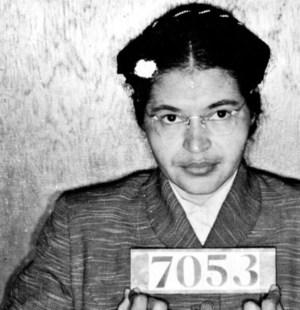 Before Rosa Parks there were more than a half-dozen women who sat at the front of the bus and were arrested. Why was it Rosa Parks’ act of defiance that led to the social movement of the Birmingham bus boycott, and not the others? It actually turns out that if you informally study the social networks, if you really look at her social networks in the community, she was tied to so many different segments of the community, white as well as black – she engaged with the dominant system as well as occupied the social spaces of the minority. Her friendships and deep ties and affiliations cut across Montgomery's racial and economic lines -- she was secretary of the NAACP chapter, was active in her church, volunteered with a botanical club and a local hospital, and she sewed dresses for wealthy white debutantes, including for the daughters of a wealthy and influential white lawyer, who -- together with the former head of the local NAACP -- helped her post bail after the arrest.
Before Rosa Parks there were more than a half-dozen women who sat at the front of the bus and were arrested. Why was it Rosa Parks’ act of defiance that led to the social movement of the Birmingham bus boycott, and not the others? It actually turns out that if you informally study the social networks, if you really look at her social networks in the community, she was tied to so many different segments of the community, white as well as black – she engaged with the dominant system as well as occupied the social spaces of the minority. Her friendships and deep ties and affiliations cut across Montgomery's racial and economic lines -- she was secretary of the NAACP chapter, was active in her church, volunteered with a botanical club and a local hospital, and she sewed dresses for wealthy white debutantes, including for the daughters of a wealthy and influential white lawyer, who -- together with the former head of the local NAACP -- helped her post bail after the arrest.
So following her arrest and bail, leaders and activists were like, "Bingo, this is the one [case] that we are going to town on." They organized a whole set of rallies in churches, all with a very deliberate systemic approach. So lawyers and movement builders who had been looking for a while from the top, looking at what are the stories emerging, saw the Parks case as one that they could channel into broader systemic change. They had been long considering what are the right stories to carry on with? Both on the protest side and on the law and Supreme Court side. There are people out there, really focusing on the systems and thinking about what is gong to be the story, the case that makes the situation tip, that helps craft a new social norm or organizing principle for society.
Abortion is another example of social change that at least in some ways arguably was led from the top. In 1973, the Supreme Court ordered that abortions had to be made safe and legal. There's a huge argument and a huge debate that has started about whether that was premature or pyrrhic for the side that achieved legal victory, in the sense of the political backlash that occurred after the legal decree. Was there sufficient groundwork laid for that legal decree to happen? There are also arguments and questions about how skillfully crafted was the legal decree. In the case of Brown versus Board of Education, it was a 9-0 unanimous decision, and a lot of ground work was laid for that. In the case of the abortion decision, it was a 7-2 decision, there was a dissent, the case was re-argued twice, the plaintiff who actually was challenging the abortion laws actually ended up delivering the baby because it took so long to decide the case. Justice Blackmun, who wrote the majority opinion spent the summer at the Mayo clinic researching all of the medical evidence around abortion, came up with this tripartite, trimester framework which ended up not lasting more than ten years – the framework was modified and chipped away at almost immediately. He produced a very detailed and analytic head-based decision as opposed to a heart-based decision, in terms of the way in which it was written and implemented.
A lot of lessons there, which I won't get into, about the difference between how that social change movement happened from the top down, versus from the bottom up. One could argue that because of Martin Luther King, Jr. and many others, because of the groundwork, Brown v. Board of Education was a decision that was more likely to stick in terms of broad public acceptance and actually channeling public consciousness over generations.
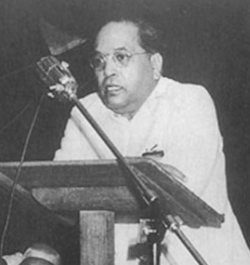 A third case I want to talk about is the Gandhi versus Ambedkar debate, which is around the annihilation of caste. Obviously Gandhi needs no introduction to this community. And Ambedkar was actually an untouchable who was also a former lawyer (like Gandhi). He actually was the drafter of the Indian constitution and the first law minister after the formation of the new republic (India) following the exit of the British. As an untouchable, he urged that caste should be abolished in the constitution. He actually wrote this unpublished and actually not delivered speech, on the annihilation of caste – and he aimed the speech for an audience of “the good Hindus.”
A third case I want to talk about is the Gandhi versus Ambedkar debate, which is around the annihilation of caste. Obviously Gandhi needs no introduction to this community. And Ambedkar was actually an untouchable who was also a former lawyer (like Gandhi). He actually was the drafter of the Indian constitution and the first law minister after the formation of the new republic (India) following the exit of the British. As an untouchable, he urged that caste should be abolished in the constitution. He actually wrote this unpublished and actually not delivered speech, on the annihilation of caste – and he aimed the speech for an audience of “the good Hindus.”
Obviously, Gandhi -- premier among "the good Hindus" that Ambedkar hoped to reach -- was against caste in his own personal life and did a lot against untouchability. But Ambedkar was appealing to abolish caste coercively via the new constitution. Gandhi responded that it shouldn't be abolished in the constitution. It was the whole debate between them – the debate between voluntary action versus coercive action.
Gandhi took the view that Hinduism should reform incrementally within itself, and that if you impose this legislatively as a mandate, a coercive mandate, it would not really lead to lasting change, a perfectly defensible position in some sense. Ambedkar, who was untouchable, was arguing against the tyranny of gradualism – urging instead for what MLK later termed “the fierce urgency of now” for justice and inclusion. He believed that at some point, one has to declare certain principles. Again, I say this because Gandhi is so revered and is the one in history that has gone down as the brilliant figure -- but on women's rights, on rights about untouchables, in South Africa his views about Africans -- these views were criticized for a very, very gradualist approach. One can talk about ripples and the need for small acts of gradual action, but I think we also need to think about how do you adopt those broader normative principles and how do you make them more systemic to speed up the process of eradicating injustice if one believes, as I firmly do, that the outer systems and social systems affect and channel and amplify in certain directions the inner work of people within the systems.
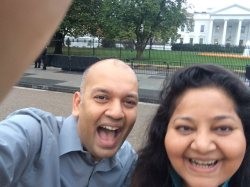 Now moving to the here and now, here's a selfie taken by our man himself. I had to touch a little bit in this discussion about our present attempts to try to bring transformation into the square, very much of the square. Nipun and I have been part of a White House Advisory Committee on eradicating poverty. As part of that we ended up leading, co-leading, this sub-committee on transforming government -- because what else would we be interested in? :)
Now moving to the here and now, here's a selfie taken by our man himself. I had to touch a little bit in this discussion about our present attempts to try to bring transformation into the square, very much of the square. Nipun and I have been part of a White House Advisory Committee on eradicating poverty. As part of that we ended up leading, co-leading, this sub-committee on transforming government -- because what else would we be interested in? :)
To tell you a little bit of my journey, I've been involved in government and the public sector as a public official for much of my life -- back and forth between the public and private sectors. Every time I would be asked to serve in a role, I would be grateful for the opportunity of service, and in each instance of service I felt proud at the end of the day by what we had accomplished -- accomplishments which in many instances were celebrated. But I also felt a nagging sense that we couldn't seem to really change the dynamics of our most pressing issues in any real transformative way. We seemed caught in a matrix. Then I would think that maybe it's just that I don't have an influential enough role, maybe I just need to keep going. I thought that maybe when I would get into a role where I could really have some influence, then I could really be in a position to make fundamental change on the big issues of our day.
I kept doing that. I worked my way along, doing all the good things. Junior lawyer, senior lawyer. Then Solicitor General of the State of New York. Eventually I'm a senior official, counselor and advisor to President Obama in the first term of the White House. Even then it was like, "Wow, even this really isn't enough. It's not about position." You know? In many ways it's like deck chairs on the Titanic. I don't want to say it's entirely that -- because obviously we did a lot of positive things -- including health care, economic recovery and foreign policy accomplishments. But a lot of the underlying fundamentals remain the same.
Looking back, and seeing all of you incredible people now, I wonder, "If I had had some of these tools, or had some of this ability to navigate difficult situations or really speak truth to power in a different way -- maybe I could have made more of an impact, maybe helped transform things more fundamentally." But then I think, "Nah. It wouldn't have moved much. The system is what it is."
That's why I was excited to see Nipun with me on this White House advisory committee convened by President Obama in DC, and I was like, "Yeah, maybe he can do it -- with his amazing skillfulness." Then we're sitting in these halls and it turns out that that may not be the case. It's really hard. We did do some good stuff. We did bring in the language of transaction to transformation. You'll see this in the report that's coming out in a couple weeks. We talked about moving from resources to relationship, how to leverage the financial capital of the state to build social capital and networks of people and peer-to-peer networks and how to create ecosystems of support among front-line workers working in impoverished communities. It wasn't this idea of the government saving poor people, it's not just giving money, it's not this idea of helping "fix" things for others, but it's like, how can you use the incredible financial capital of the state to seed a process of transformation so that the subjects themselves feel empowered, rather than made into objects?
In our final report, we ended up focusing a lot on the front line of delivery. It's all about that moment when the government worker is in contact with the recipient, so to speak, and how to turn that into a transformational moment -- focusing a lot on the relationships and various tools of empowering government workers with some of those tools. Maybe some ripples will occur. At least we started the process of articulating the change.
Just to summarize a little, I'm kind of drawing upon Marshall Ganz's work and altering this a little bit as I think about the relationship of inner transformation to social change, that I've learned especially through this ecosystem. Marshall focuses a lot of the centrality of narrative, and I'm tweaking his framework.
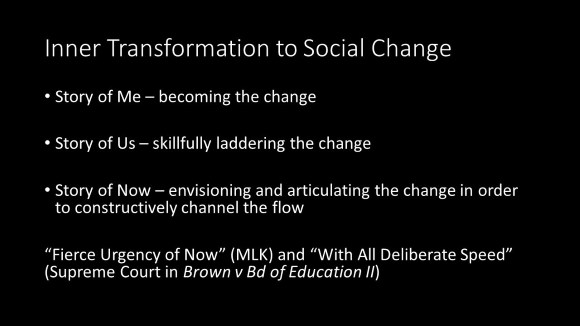
The story of me, which is first, is about becoming the change. There is then a story of us, which is skillfully laddering the change -- through the kind of peer-to-peer networks and circles that we have here -- and I think that's where this ecosystem is operating so beautifully.
And I think there's also a third piece of this which is the story of now, which is articulating and envisioning the change in order to constructively channel the flow that emerges from all this laddering. That's the piece I would love to see more of. Drawing awareness and consciousness to the nature of the systems in which we operate -- the food system, the financial system, the governance system, etc. -- so that we can be aware of the underlying design principles and begin to consider possible redesigns or adjustments. There's already so much rich material in the ServiceSpace ecosystem. Not just the heart work, not just the inner work, but the brain work. The work of systems thinking that I have seen -- whether through the Awakin Call speakers, whether through DailyGood, whether through KarmaTube, it's all top notch. It's better than almost anything else out there -- I read a lot and it's among the best stuff I read.
So I feel like it's all there. It already exists. It's a matter of putting it together, envisioning it, articulating the change – yes, even via white papers.:) Telling the story of now, and in the words of MLK, with a "fierce urgency of now". I worry a little bit, about focusing only on the ripples and the many many generations. It feels a little bit like Gandhi's incrementalism on even a glaring social injustice such as caste. I get that we're all operating in different spaces, but it feels to me like we have to be able to articulate how these systems are constraining us, and really bring people in to that discussion with a fierce urgency of now. Or as the Supreme Court said in Brown versus Board of Education, "With all deliberate speed."
It's balancing the ripples. It's balancing that small behavior with the systems thinking that allows the inner and outer dance to be integrated. I think of law and systems and government as a tool, just like digital tools. They can be used for the good or they can be used for the bad. How can you bring consciousness into their design to foster inner transformation? That's why I started a little bit with the founders of the Constitution, because I do think they had that in mind. I think we have a framework from which we can operate. It's a framework that is derived from English common law. It's a framework that Gandhi drew from and utilized skillfully, in many ways, in order to push for Indian independence. He was able to use the principles against them in the same way that I think there is a solid set of principles that can be used to articulate the story of now. It's a matter of skillfully harnessing those principles and articulating the change in order to be able to push for the circle within the square.
That was just a little bit more of my own personal riff, but the reason I'm feeling really passionate about this is that I really feel like we're at a inflection point in our history. One of those multi-century inflection points similar to what we saw with the rise of the printing press – which led to the decline of the Holy Roman Empire, the rise of nation states, the Enlightenment. So many things started happening at least in part because of that and that kind of transformation happens every couple hundred years.
Then a few hundred years after the printing press, we had the industrial revolution. The invention of the steam engine in the late 18th Century led to factories, urbanization, and an outpouring of moral, political, social and economic philosophy – from Adam Smith to Rousseau and Mill – leading to modern governmental and market institutions. And mass-production of steel and of railroads in the late 19th Century made widespread the use of the corporate form -- which actually, ironically, began with the East India Company. The East India Company was the first modern corporation, but it became wide-spread after the spread of the railroads because they were organized as limited liability companies.
I feel like we're at one of those inflection points now with technology where a lot of our seventeenth and eighteenth century institutions of governance are going to go by the wayside. I think there's an opportunity in this moment of disruption to articulate something and really articulate something that will tap upon the emerging collective consciousness that we all feel in this room.
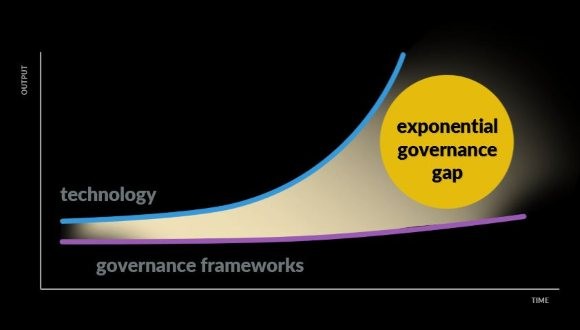
One of the things I talk a lot about is, what I call, the exponential governance gap. We have technology growing exponentially, we have the capacity of our governance frameworks at best, rising slightly, if not going down. What we have is an exponential governance gap and the only way we're going to fill that gap is by not simply working where I've worked my whole entire career, which is within those governance frameworks, but rather also where ServiceSpace is operating -- which is within that gap. I see the rise of more peer-to-peer systems of governance and ultimately, self-governance which is going to have to go fill that gap. I don’t see a way where we can have these top-down governance systems continue to manage this consciousness and the flow. I see the real innovative work happening where ServiceSpace is happening ... and I think a lot of our upcoming work should be around the awareness of external conditions, the various systems that constrain us, understanding how to skillfully use their principles against them and being part of articulating the change. It's not just being the change but it's also channeling it and articulating the change. It's the story of me, the story of we, as well as the story of now.
I would just end with the statement that I've said repeatedly. In my own experience it's been: “From the Supreme Court to the White House, I finally found the right house.” [Note: the photo below is the home/space where Awakin Circles were started and continue to be held in Santa Clara, and where ServiceSpace was founded.]
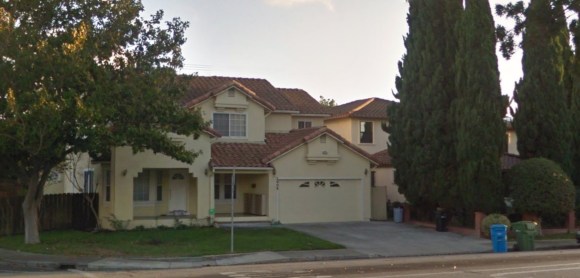
Posted by Preeta Bansal on Sep 30, 2016
SHARE YOUR REFLECTION
21 Past Reflections


On Oct 10, 2016 Jyoti wrote:

On May 6, 2018 Jerry wrote:

On May 10, 2018 Ana wrote:
I can read this article many times, over and over again, because you point to where I have felt despair, and now
understand,and am full of hope in the birth that can happen. I am in the Philippines, and yesterday, I was presenting to the President and Treasurer of our school, and in two slides, I pointed to a "gap". While we have a circle (mobius strip) our system becomes small triangles and large triangles throughout the day. After reading your article, I am so grateful. I feel, I cannot stop the triangles because they are necessary for creating order. But as long as we can come back to circle, on our deepest levels, growth will happen. Sometimes it is fast, and sometimes it is slow. We ripple in the Philippines with you, from you. Thank you !

On Jun 12, 2018 Preeta wrote:


On Sep 8, 2018 James wrote:

On Sep 8, 2018 James wrote:



On Mar 2, 2019 Rajalakshmi wrote:
Loved reading your thoughts and experience. Thanks for this deep reflective and open sharing.

On Jul 19, 2019 Mani wrote:


On Jul 11, 2020 Claudia Vega wrote:

On Jul 11, 2020 Rajalakshmi Sriram wrote:

On Jul 13, 2020 Kiran Ladwa wrote:
"I think of law and systems and government as a tool, just like digital tools."
These are emboldening statements that stood out to me. Thank you!

On Oct 8, 2020 Tom Dietvorst wrote:

On Oct 28, 2020 Fran wrote:

On Mar 6, 2021 Barbara Schwartzbach wrote:

On Mar 10, 2021 Ad G wrote:



On Oct 1, 2016 Birju Pandya wrote:
1 reply: Postme | Post Your Reply